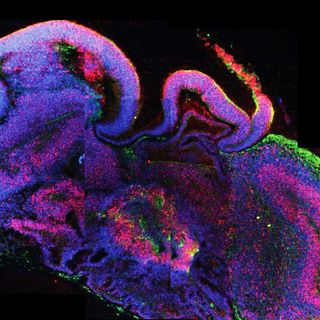
In a First, Scientists Identify the Genes Associated With Left‑Handedness
It’s time to let die the myth that left-handednes can and should be corrected.

Last year, at a wedding, I was served lunch on a banana leaf without any cutlery. Guests sat facing each other, and when I looked up, I realized two women had been staring at me. I thought it was to do with the way I was eating, because I’m not used to eating with my hands. But my friend told me they were giving me those “disgusted” looks (in her words) because I was using my left hand to eat.
I’m a left-handed person. I eat and write with my left hand. My problems started the day my grandmother noticed that my left hand was dominant and set out on a mission to ‘correct’ it because using the left hand is considered inauspicious. You don’t, or aren’t supposed to, serve or eat food with your left hand because it is associated with dirty or impure things.
I’m sure my experiences as a left-handed person are not limited to me. As many as 12% to 15% of the world’s population is left-handed and, like me, has faced trouble using a pair of scissors (the blades of which are aligned in a way that keeps us from seeing clearly along the line) or writing exams on desks that are designed for the right-handed. Even the contours of the external computer mouse are designed to best suit the needs of the right-handed.
Yet, instead of introducing tools that are left-handed-friendly, or incorporating techniques that will support southpaws, teachers and families, like my grandmother, continue to employ efforts to ‘correct’ our left-handedness. Take for example, a case Sandeip Vishnoi, who is the founder of the Indian Left Hander Club, recounted to Economic Times: in Rajasthan, a child was repeatedly punished in school for using his left hand. “But he just couldn’t write with his right and finally was asked to leave,” Vishnoi said.
Very few understand or know that being left-handed is not something we choose; it’s the way our brains are wired. And, for the first time recently, scientists have identified the gene and related brain differences linked to left-handedness.
Led by researchers at the University of Oxford, and published in the journal Brain, the study identified genetic variants associated with left-handedness. They reached this conclusion after analyzing the genomes — the complete set of genes or genetic material — of about 400,000 people from a U.K. biobank, including 38,332 left-handers.
Of the four genetic regions researchers identified, three were associated with proteins involved in brain development and structure. These proteins, they said, were related to microtubules, which are part of the scaffolding inside the cells, known as the cytoskeleton, which is responsible for the construction and functioning of the cells in the body.
Upon imaging the brains of at least 10,000 of these participants, researchers found that the differences in genetic effects were found in white matter tracts — which contain the cytoskeleton of the brain — that join language-related regions.
“Around 90% of people are right-handed, and this has been the case for at least 10,000 years. Many researchers have studied the biological basis of handedness, but using large datasets from UK Biobank has allowed us to shed considerably more light on the processes leading to left-handedness,” Dr. Akira Wiberg, a medical research council fellow at the University of Oxford who carried out the analyses, said in a press release. He added, “We discovered that, in left-handed participants, the language areas of the left and right sides of the brain communicate with each other in a more coordinated way. This raises the intriguing possibility for future research that left-handers might have an advantage when it comes to performing verbal tasks, but it must be remembered that these differences were only seen as averages over very large numbers of people and not all left-handers will be similar.”
Related on The Swaddle:
Study: Kids’ Physical Play Linked to Improved Academic Performance
“For the first time in humans, we have been able to establish that these handedness-associated cytoskeletal differences are actually visible in the brain. We know from other animals, such as snails and frogs, that these effects are caused by very early genetically guided events, so this raises the tantalizing possibility that the hallmarks of the future development of handedness start appearing in the brain in the womb,” Professor Gwenaëlle Douaud, PhD, a joint senior author on the study, from Oxford’s Wellcome Centre for Integrative Neuroimaging, also said in the press release.
Therefore, if left-handedness is really simply out of one’s hands, there’s nothing to correct. Anythinglefthanded.co.uk, an organization of people providing products and information to make life a bit easier for left-handers around the world and campaigning to promote awareness, acceptance and empathy for left-handers, says forcing people to change their dominant hand has many implications.
“The dominant writing hand is not just a physical thing to do with controlling a pen but a mental thing to do with the way the brain is organized and where certain functions occur. The brain is ‘cross-wired’ to the body, so the left-handed side of the brain controls the right-hand side of the body, and the right side of the brain controls the left. Changing the hand used for writing causes great confusion in the brain and can have a lot of knock-on effects,” mentions their website.
These effects could include bed-wetting, nail-biting, stuttering, bad handwriting, poor concentration, reading difficulties, shyness or being withdrawn, poor memory or physical tiredness.
“These problems will not definitely occur in all people who have their writing hand changed and of course they can arise due to many other causes, but there does seem to be an association between all of these issues and a forced change of writing hand,” the website adds.
So, this is a personal appeal: that the world around us left-handers, which is largely designed for the right-handed, should see this finding as an opportunity to create and supply for the needs of people who are left-handed. I can get them started with the list of things I want: for starters, left-handed scissors and can openers; shirts with pockets on the right, too; jeans with zip flaps on the right, and keyboards with numerals on the left.
What I don’t want — “disgusted” faces when I eat or serve with my left hand, or comments about how I must be so creative. And also, please stop being so amazed and amused. Being left-handed may be rare, but it’s so normal it’s genetic.
Anubhuti Matta is an associate editor with The Swaddle. When not at work, she's busy pursuing kathak, reading books on and by women in the Middle East or making dresses out of Indian prints.
Related


Scientists Warn Mini‑Brains Used in Lab Research May Be Able to Feel
